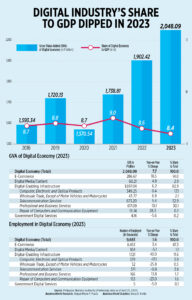(Part 2)
The Philippine Congress should replicate its outstanding performance in passing laws that will accelerate the employability and competitiveness of the Filipino workforce in such other critical areas as health, agribusiness (especially in abolishing the many obstacles to the consolidation of farms that resulted from the failed agrarian reform program), the ease of doing business, etc. This is one reason why a good number of us who appeared in hearings of both the House of Representatives and the Senate on the charter change bill opined that the amendment of the Constitution is not an urgent matter. We felt that such an unnecessary effort at this time (advertising, media and educational institutions will not bring large sums in FDIs) will only distract our lawmakers from more pressing issues that require legislative acts.
More examples of recent bills proposed for the benefit of the Filipino workers are the Enterprise-Based Education and Training to Employment Act (Senate Bill No. 363 and House Bill No. 7400) which aims to establish a national enterprise-based education and training (EBET) system that is competency-based and supports work-based training. Similarly, Senate Bill No. 2491 of the National Apprenticeship Program Act of 2023 aims to clarify the articulation of apprenticeships currently based on the Labor Code. Multiple interpretations of the different types of work-based training modalities have led to difficulties in passing laws that support industry-led training programs. For example, the Dual Training Act of 1994 (especially championed by former President Fidel Ramos himself), the Labor Code of the Philippines, and the upcoming bills involving work-based training programs must thoroughly define the different modalities. Industry investment and involvement are crucial in the implementation of work-based training modalities. It is important that the overall framework is aligned with industry needs. The roles of the government, industry, and the academe must be clearly delineated.
To highlight even more the desirability of enlightened legislation on this matter of access by the Filipino workers — both present and future — to skills development opportunities, it is important that these training programs be integrated into a comprehensive lifelong learning framework that maps out all available workforce development pathways. This would require the harmonization of existing frameworks such as the Philippine Qualifications Framework, Philippine Skills Framework, and the Philippine Credit Transfer System.
To cite a very specific example of the need for a lifelong learning framework, a few graduates of the dual training system from the leading example of this modality — the Dualtech Training Institute located at the Carmelray Industrial Estate in Canlubang, Laguna — have been able to use the ladderized system to pursue a college degree in engineering, then to a masteral degree in an allied field, and ultimately all the way to a Ph.D. I cite this example to illustrate that having a comprehensive lifelong learning framework will democratize our educational system even more by enabling the highly qualified graduates of our Technical Education and Skills Development Authority (TESDA)-type schools to still aspire to obtain the highest academic degrees that are usually accessible to only the children of the well-to-do. We will give opportunity to Filipino youth who start out as electricians, for example, in their first occupation to eventually acquire a BS in Electrical Engineering through the ladderized program and all the way to a Ph.D. in electrical engineering, or, should they go up the management ladder, work for an MBA. The reverse case would be the possibility of a graduate of a college degree (such as accounting or law) to train to be a mechanic if that is what would enable him to get a better job in the future. Already there are many college degree holders who later take TESDA-related courses to improve their chances of employment.
In all of these, industry participation is absolutely necessary. While some industry associations and business consortia are already established, the lack of clarity over which government agencies to engage with for workforce development initiatives is crippling their effectiveness. Multiple government agencies — such as the Commission on Higher Education (CHED), TESDA, Department of Agriculture (DA), Department of Tourism, the Department of Information and Communications Technology (DICT), Department of Trade and Industry, and Department of Labor and Employment (DoLE) — are individually implementing their own industry engagement initiatives.
This is a perfect example of what I hear from prospective foreign direct investors who complain that “the right hand of the Government often does not know what the left hand is doing.” Each government agency produces valuable information for workforce development initiatives, but these seem to have caused confusion, with overlapping functions, and additional red tape that discourages industry participation.
Up until very recently, few industry sectors had a clear direction as regards the development of skills and competencies in their respective industries. Theoretically, industry boards were tasked to provide TESDA and the private sector a proper mechanism and venue to collaborate on setting training standards, co-developing training curricula, and crafting policies that strengthen the ability of industries to invest in workforce development. Lamentably, there have been only 40 Registered Industry Boards (RIB) across eight sectors operating at the national, regional, and provincial level. TESDA has not been able to maximize these RIBs. This has led to weak industry engagement resulting in the failure to fully mobilize and harness the 1,109,64 recorded business enterprises in the country.
Today, there is a great clamor for accurate data in formulating any solution to an economic or management problem. As the recently appointed Agriculture Secretary Francisco Tiu Laurel, Jr. realized, the appropriate policies and programs in his department could hardly be formulated without accurate data. That is why he started his term by making sure he would benefit from the new science of data analytics before trying to look for solutions to the many problems related to food security.
In the same way, in the labor sector, organizing RIBs would serve as the primary point of contact for efficient information sharing in the setting of standards for the mastery of targeted skills, learning outcomes, and needs assessment for in-demand skills across all government agencies. Moreover, it would unlock the ability of industry sectors to develop the accurate market information, lobby for policies to minimize government red tape, co-develop policies to maximize economic returns on investment in workforce development, to negotiate for incentives, and identify more effective training and upskilling pathways for labor market needs.
Industries would also benefit from increasing their engagement with their local Public Employment Service Offices (PESOs), especially since these offices, in varying capacities, gather data on the employment status of local residents and provide direct information on labor market trends. Jobs-skills mismatch has already become a widespread issue, and it would benefit industries to take the lead in determining how the LGUs can support them in addressing this problem at the local level.
(To be continued.)
Bernardo M. Villegas has a Ph.D. in Economics from Harvard, is professor emeritus at the University of Asia and the Pacific, and a visiting professor at the IESE Business School in Barcelona, Spain. He was a member of the 1986 Constitutional Commission.






